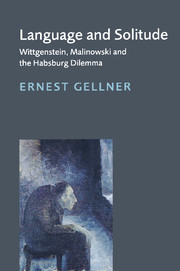Book contents
- Frontmatter
- Contents
- Preface
- Foreword
- Part I The Habsburg dilemma
- Part II Wittgenstein
- Part III Malinowski
- Part IV Influences
- 32 The impact and diffusion of Wittgenstein's ideas
- 33 The first wave of Wittgenstein's influence
- 34 A belated convergence of philosophy and anthropology
- Part V Conclusions
- General bibliography
- Bibliographies of Ernest Gellner's writings on Wittgenstein, Malinowski, and nationalism
- Index
32 - The impact and diffusion of Wittgenstein's ideas
Published online by Cambridge University Press: 05 March 2010
- Frontmatter
- Contents
- Preface
- Foreword
- Part I The Habsburg dilemma
- Part II Wittgenstein
- Part III Malinowski
- Part IV Influences
- 32 The impact and diffusion of Wittgenstein's ideas
- 33 The first wave of Wittgenstein's influence
- 34 A belated convergence of philosophy and anthropology
- Part V Conclusions
- General bibliography
- Bibliographies of Ernest Gellner's writings on Wittgenstein, Malinowski, and nationalism
- Index
Summary
Wittgenstein's ideas (i.e. those connected with his ‘later’ philosophy) spread in a number of waves or currents, which it is useful to distinguish. These need to be given names. Three of them in particular are of interest. The names I shall give them are code terms and are to be used without prejudice: the ideas of these trends overlap, and the stress suggested by the name of any one of them may refer to something which is not necessarily absent in the other trends. The names to be used are:
Philistinical exorcism;
Relativistic idealism;
Expiatory hermeneutics.
The first two are explored in this section and the next; for the third, see section 34 below.
Wittgenstein used the ‘cultural practical involvement’ theory of language to escape from the dreary solitude of the world of the Tractatus – there being nothing else. All worlds were solitary and similar, for there could be no other kind. As this depressing vision was a consequence of a theory of language, if that theory came to be seen to be deeply misguided, and the only alternative theory gave us a, relatively speaking, much cosier world of the closed speech community with its ‘form of life’ – well then, this escape was warmly welcome. The déraciné and despised Viennese Jew escaped on the shoulders of the Transcendental Ego and his escape ladder (language): or, alternatively, you can say that the Transcendental Ego, equipped with ladder but with nowhere to go, was shown by the Viennese Jew that there were all these gemütlich communities to which one could escape, if only one could get to them.
- Type
- Chapter
- Information
- Language and SolitudeWittgenstein, Malinowski and the Habsburg Dilemma, pp. 159 - 163Publisher: Cambridge University PressPrint publication year: 1998



